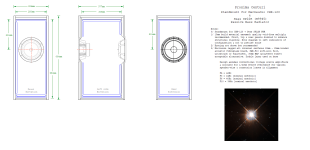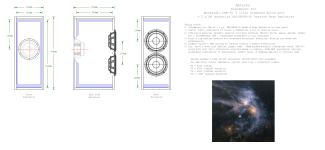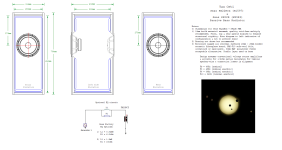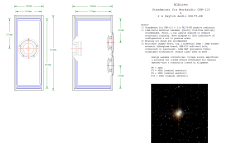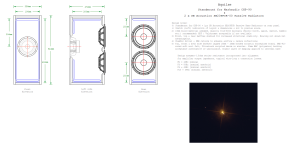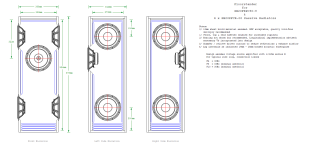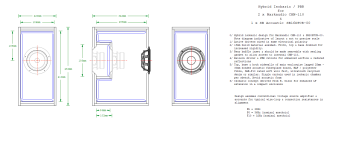I see somebody has been reading Not Much of an Engineer. 😉
Of course, in Sir Stanley's case it was about the highest form of irony possible, as I'd rate him as one of the greatest engineers in history, up there with Sir William White, John Scott Russell and the Wright brothers. Muggins here can't even get a menial job -and with good reason.
Of course, in Sir Stanley's case it was about the highest form of irony possible, as I'd rate him as one of the greatest engineers in history, up there with Sir William White, John Scott Russell and the Wright brothers. Muggins here can't even get a menial job -and with good reason.
There are those who have argued (and cogently) that in audio, if you're not cheating, you're not trying hard enough.
So: Aquilae for CHP-90 + twin SB20PFCR-00 8in passive radiators.
So: Aquilae for CHP-90 + twin SB20PFCR-00 8in passive radiators.
Attachments
Last edited:
Short version is assuming they're used properly, they don't (same as vents). A longer version is that a PBR enclosure is basically the mechanical equivalent of a notched electrical high pass filter; below the knee of the transfer function it unloads initially 5th order, then bounces back up a little, exact details depending on the design, & transitions to a 2nd order. So compared to an equivalent vented box, they have slightly higher group delay -assuming a vented box is practical. Passive radiators really come into their own when you have a driver that requires an acoustically small volume with a low tuning frequency; conventional vents can be problematic in those cases as you're fighting for a balance between avoiding excessive duct length (potential for audible self-harmonics) or an excessively small cross-section (causing excessive air velocity & flow-noise). In most other scenarios, you're really using them 'just because', although there can be some potential to adapt polars more than you may be able to with regular vents, or slightly alter room interaction.
Last one for now as I had a few of these in the works over the last few weeks, & since I've only a handful of minutes access to my desktop at the moment, took the opportunity of finishing this one off. Slightly different this time, combination of isobaric & PBR
Attachments
Basically exactly as I've previously described. 😉 Summarizing, the primary value of an isobaric enclosure is to allow a low tuning in a reduced cabinet size -they may offer a small reduction in distortion although this is arguably six of one, half a dozen of the other as there are conflicting factors at work. Passive radiators are essentially just a vent substitute, so their main value is in acoustically small cabinets with a low tuning when conventional ducts may be problematic in either excessive length (resulting in audible self-harmonics), or an excessively small cross section (increasing the chance of flow-noise etc. due to the greater velocity). Neither of those are a problem with the original isobaric version (I wouldn't have released it otherwise), or any of the regular vented boxes I've done for the MA units; as noted they're really 'just because' -valid but not technically necessary, though given the positioning they may interact with the room a little differently, and the alignments are a little different also as there's less freedom to make adjustments. Some people just like passive radiator designs / the idea of them in general, so I'm simply giving them a few options as there aren't too many around. More or less the same applies to the Seas box: the SB is a little different in that it needed four for a reasonable alignment & box size, so since I had the numbers & plenty of clearance, I went for the distributed lateral push-push layout.
Last edited:
I have 4x 11ms', which are in a pair of Seastacks and Nostromos. They're great, but I'm not using both so now I'm wondering about something new using all 4 drivers.
I see the 11ms bipole in this thread, as well as the dual 10.3 mltl... Are either of these, or a similar/new design, worthwhile pursuing over the Seastack?
Thanks in advance!
I see the 11ms bipole in this thread, as well as the dual 10.3 mltl... Are either of these, or a similar/new design, worthwhile pursuing over the Seastack?
Thanks in advance!
Any design with one driver can be scaled.
For Seastack for instance, double the cross-section, and then either place the 2 driver on the front baffle with the Zd right between the 2. I think a sdie mounted side mounted driver might ve best, gives some bass support without necessarily need a low pass on the second driver, and avoiding the bipole dip that happens if you put it on the back.
dave
For Seastack for instance, double the cross-section, and then either place the 2 driver on the front baffle with the Zd right between the 2. I think a sdie mounted side mounted driver might ve best, gives some bass support without necessarily need a low pass on the second driver, and avoiding the bipole dip that happens if you put it on the back.
dave
Have you designed any Isobaric speakers using either the A10x or MAOP10x drivers?Last one for now as I had a few of these in the works over the last few weeks, & since I've only a handful of minutes access to my desktop at the moment, took the opportunity of finishing this one off. Slightly different this time, combination of isobaric & PBR
Or do you have any such designs in the works?
I haven't: to the best of my knowledge, the 10.3 / 10P / MAOP10 will be discontinued (except for OEM or bulk orders) when Markaudio have run though the remaining stock of components, so I didn't think it would be worth putting the time into developing a new open-source design. I can look into working one up on a custom commission basis in the event anybody wants one though, but that's a private issue & I'm emphatically not on this forum for commercial purposes.
- Home
- Loudspeakers
- Full Range
- Miscellaneous designs - Markaudio, Fostex, TB, Dayton, SEAS etc
